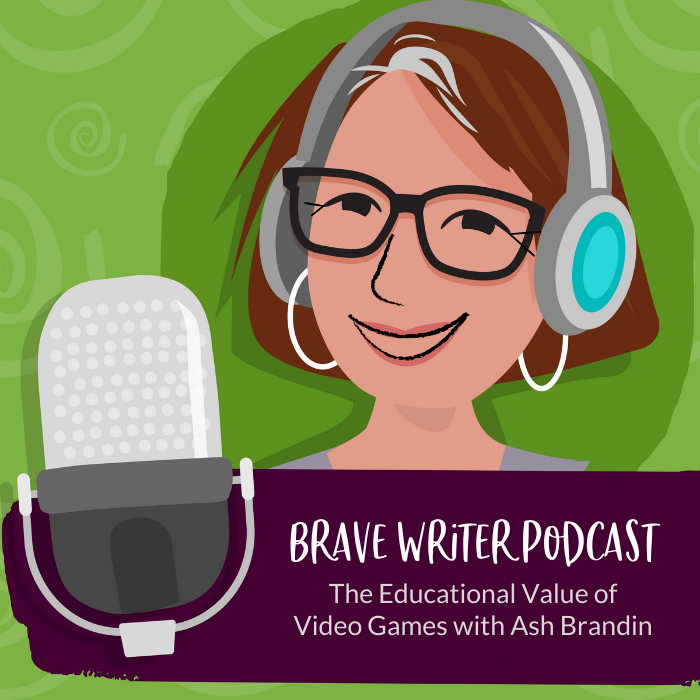Podcast: The Educational Value of Video Games with Ash Brandin

Raising five kids during the internet era, everyone is dying to know what my thoughts on video games are! How many hours, how many minutes, how many days? Are they too violent? Is it okay if they love Minecraft? Will they lose all motivation to work? Let’s discuss all this and more!
Ash Brandin (they/them) is a middle school teacher from Golden, Colorado. After researching the use of video games in classrooms, Ash found that there was very little research about how games compel people to play, and how this can be brought into the classroom — or any educational environment.
Since 2016, Ash has spoken across the country about how academic spaces can mimic game structures to make learning compelling, motivating, and engaging. They believe games, specifically entertainment based games, can help us create better teaching, more engaged learning, and motivated lifelong learners.
Listen to the Podcast
Show Notes
How Much is Too Much?
When your kids are away at school for several hours of the day, there is less potential for video games to take up a large portion of their time. But when they are home most of the day, how much gaming time is acceptable?
With how many games being mobile, it can be tough to monitor and micromanage. In general, when kids are engaging in screen time, we need to be asking ourselves:
- What is the quality of engagement?
- What is the purpose of this activity?
- Do we see this creating a problem somewhere else?
We don’t want to create a scarcity mindset by treating video games as something limited and exceptional. We want them to have access and exposure to these things while also keeping them open to letting you see what they are consuming. When you have leisure time blocked off for the day, let video games be one of the options available to your kids. You want to find a way to put it in the day in a structured way that allows kids to engage with it. When we create a bit of structure in how we use video games, it introduces kids to a way to structure it for themselves.
The Role of Video Games
Parents are always trying to understand why video games are so compelling to their kids. Much of that comes from how video games offer intrinsic motivation. Educators are usually aware of intrinsic (from within) motivation and extrinsic (from without) motivation. We often use video games as an extrinsic motivator, such as “when you finish your homework, you can play Minecraft.” But the games themselves operate off of intrinsic motivation.
Three factors make intrinsic motivation work:
- Competency
- Autonomy
- Relatedness
We often think of rules as restrictive, but when we shift to thinking about rules in games, they are the thing that makes games fun. Think about a board game: When you pull it out, the first thing you do is read the rules. It tells you how to play the game.
One thing video games do very well is that they present a very clear world and don’t change. If we know the rules, we know what to expect. When those rules are broken, we feel a loss of control. Paradoxically, rules give us a heightened sense of control because we know exactly what we can do within those sets of rules.
How Video Games Create Resilience
One thing that video games do well allows kids to experience a microcosm of failure in a completely safe environment. When they jump for a platform, miss, and fall into the lava, it can be frustrating. But they can immediately try again. They get to learn from their mistakes, and when they do make it, the feeling of accomplishment far outweighs the disappointment of failure.
Games make this work by incrementally increasing the difficulty so that there is always a sense of mastery without too much frustration. This technique can be used in educating as well. If we present kids with slightly more difficult problems, or we take something they’ve seen before but show it to them in a different way, that gives kids the opportunity to engage with an activity in the same way they would with a game.
Reframing Video Games
When we see video games solely as leisure, we run the risk of minimizing their value. If we only view them as escapism, then we ignore all of the things that they allow our children to feel, express, or learn that they wouldn’t be able to otherwise. We understand that children learn through play, but that’s not exclusive to physical toys. Experimentation through video games offers immediate feedback in a way that’s not judging, that’s not suggestive, and allows kids to try things out in a safe, rule-based environment. If we can see past the immediate appeal of the visual aspects, we can acknowledge the resiliency it builds and as a way to practice the life skills, we want all children to have.
Resources
- ashbrandin.com
- Instagram: @ash.brandin
- Want help getting started with Brave Writer? Head over to bravewriter.com/getting-started
- Sign up for the Brave Writer Newsletter to learn about all of the special offers we’re doing in 2020 + you’ll get a free 7-Day Writing Blitz guide just for signing up: go.bravewriter.com/writing-blitz
Connect with Julie
- Instagram: instagram.com/juliebravewriter
- Twitter: twitter.com/bravewriter
- Facebook: facebook.com/bravewriter


















